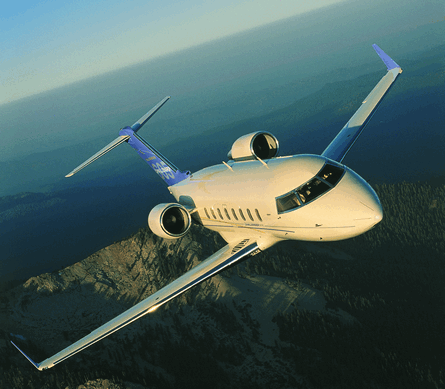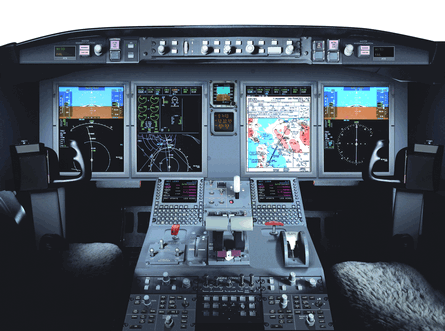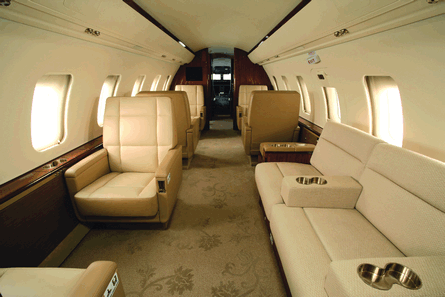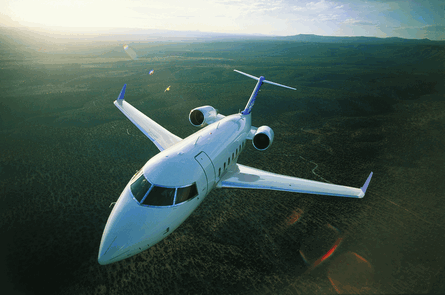The Challenger 605 large-cabin business jet, the latest evolution of Bombardier's venerable Challenger line, was launched at the US National Business Aviation Association's Orlando convention in 2005. Tracing its roots to the 601, the 605 represents the fifth major evolution of the world's best-selling large business jet. Continuous product improvement has been the hallmark of each successive Challenger model, with the 605 being no exception.
 |
|---|
© Bombardier |
The original 601 had a range of 5,190km (2,800nm), while the 605 offers intercontinental capability with a range of 7,490km. Compared with its immediate predecessor, the 604, the 605 offers a 90kg (200lb) payload increase. The additional capability allows one more passenger to be carried on the 605 than on the 604 on a similar stage length. Substantial improvements have also been made to the flightdeck and passenger cabin.
The 604's Collins ProLine 4 has been replaced with the newer and seemingly ubiquitous ProLine 21. A Rockwell Collins head-up display and Bombardier enhanced vision system are options on the 605. Enlarged windows and more reliable LED lighting headline passenger cabin enhancements.
 |
|---|
© Bombardier |
Picture Windows
Challengers are renowned for their large passenger cabins. At 2.49m (8.2ft) wide at the sidewall and 2.19m wide at the floor, the aircraft feels roomy. Height over the aisle is 1.85m, offering true stand-up height from a flat floor. A redesign of the passenger service units (housing oxygen masks, gasper outlet and reading light) over the seats gives them a shallower profile, and 50mm (2in) more headroom. The largest change to the cabin is its 16 windows. Window area has been increased by making them 410mm high, 50mm taller than those in the 604. Width remains unchanged at 255mm.
Perhaps more importantly, the windows are placed 64mm higher in the sidewall, allowing comfortable sightseeing without bowing the head. The interior window reveal has also been redesigned, and combined with the greater glass area allows 30% more natural light into the cabin. Cabin lighting has also been upgraded with the addition of LED fittings.
Bombardier offers four floor plans for the 605. The standard nine-seat interior provides club seating for four forward with a three-place divan and two individual seats aft. A spacious lavatory is at the cabin's aft end. The 3.25m3 (115ft3) baggage compartment is accessible in flight through a door in the lavatory's aft wall. An 11-passenger floor plan is available with four narrower seats arranged in a club configuration placed opposite the divan. The third plan has an extended lavatory with seating for nine in an effectively shorter cabin. The final floor plan seats 11 with an extended lavatory.
All four versions have an enlarged galley. Designed with extensive customer flight-attendant input, it features a large work area and an LED touchscreen controller for the cabin entertainment system, water system, communications system and cabin environment.
The digital Ethernet-based entertainment system in standard configuration has two 18in LCD monitors mounted on the left forward and right aft cabin bulkheads. Optional 21in monitors were installed on the flight-test aircraft. Eight speakers are provided, and source equipment includes dual DVD/CD players, Airshow ASX and any number of carry-on devices such as iPods. An Iridium satellite communications system is standard and an airborne office suite includes an in-cabin wireless network and Inmarsat high-speed data and voice capability. Two independent air conditioning units provide a comfortable environment while increasing dispatch reliability. The units are air-cycle machines, requiring no freon or other cryogenic gas.
 |
|---|
© Bombardier |
Office Windows
The Challenger 604, with its ProLine 4 avionics system, was the first business jet to sport an all-glass cockpit. The then leading-edge ProLine 4 featured six CRT displays and an engine indication and crew alerting system (EICAS). In 2002 Collins marketed a retrofit ProLine 21 Continuum avionics suite for older Challengers with 8 x 10in LCD displays. The Continuum package, however, retained the conventional round-dial engine instruments and caution and warning panel. The ProLine 21 system in the 605 has four 10 x 12in LCD displays and an integrated EICAS. The total display area has increased by 55% over the 604, a welcome increase. The displays are oriented on the forward instrument panel in a portrait format, two per side. A single digital clock and integrated standby instrument are in the centre of the panel.
The displays are used in a conventional format, with the two in-board multifunction displays (MFD) flanked by captain and flying officer displays. Communications/navigation and identificatiion friend-or-foe information is displayed at the top of each MFD. Either of the pedestal-mounted flight management system (FMS) control panels or two display control panels can be used to change frequencies and IFF codes. Each MFD can be divided into an upper and lower section. The upper section typically displays EICAS information. The lower section hosts a number of system synoptic pages as well as an FMS map and flight plan with traffic, weather radar and traffic overlays. An electronic checklist is standard. As only three displays are needed to show critical information, the fourth can be used to display full-screen FMS maps as well as Jeppesen charts.
In its baseline configuration the 605 is "e-charts"-capable. The charts - digital files of conventional ones - are easily viewed on the large MFD, with ownship position presented. The ability to see aircraft positions on airfield diagrams will significantly increase safety by reducing the chances of a runway incursion. Chart orientation on the MFD can be changed, a nice feature when charts are published in a landscape format. Chart scale can also be magnified, a boon to those with ageing eyes. Two file servers are standard on the 605, giving its cockpit chartless capability.
High-Tech Window
A Rockwell Collins HGS-6605 head-up display is an available option for the 605. This active-matrix LCD system offers a 42 wide by 30° high field of view. As with other commercial and military systems, it presents primary flight information in the pilot's forward view and should greatly enhance situational awareness. Flight director guidance is provided in the HUD as well as a flightpath vector. This is also displayed on the head-down displays, even if the HUD is not installed.
While the HUD can be bought as a standalone option, it will typically be ordered to support Bombardier's enhanced vision system. At its heart is a CMC Electronics dual band (short- and mid-infrared) CMA-2600i sensor. Mounted on top of the nose it provides a nominal 30 x 30° field of view with 256 x 256 pixel resolution. The principal benefit of the system is to allow descent below normal Category 1 minimums to a decision height/minimum descent altitude of 100ft above touchdown zone when natural light cues are unavailable. Additionally, it should increase pilot situational awareness during low visibility and night time operations. US Federal Aviation Administration certification is expected by October. Bombardier says around 20% of its 605 customers are opting for its $687,400 enhanced vision system.
Window of Opportunity
Flight International put the 605 through its paces during a flight from Bombardier's Hartford service centre. The test aircraft, N605BA, had a standard nine-seat interior but lacked the still-uncertificated optional HUD and enhanced vision system. The safety pilots for the flight were Yves Tessier, a former Canadian Forces Boeing CF-18 Hornet pilot and David Ure, a current Fairchild A-10 pilot in the US Air National Guard.
During the pre-flight walk-around inspection they pointed out unique aspects of the 605. The aircraft has a large ramp presence, befitting an aircraft with the widest cabin of any dedicated business jet. Visually the only readily identifiable differences between the 604 and 605 are the larger windows and the tail cone. The 604's cone has a straight vertical trailing edge, not unlike the Boeing 777's, while the 605's cone is rounded.
The auxiliary power unit, which exhausts on the right hand side of the tail, was running to warm the aircraft on the cold 3°C (37.4°F) day. APU noise was generally low, with conversation somewhat strained near the tail. With the exception of the winglets, the wing is unchanged from the original Challenger 601. The leading edge is fixed, and de-iced with bleed air over the majority of its length. The sturdy trailing link main landing gear retracts into the wing. While the cabin features LED lights, Bombardier has yet to upgrade the Challenger's external lights to that more reliable type.
Entry to the cabin is via a large non-plug door with integral boarding steps. The counter-balanced door is easy to open and close and features a single static seal. The cabin has a high level of appointments for a serial production interior. Wide leather seats are inviting, with wood fold-out tables available at all stations except the three-place divan. Entertainment system control panels are also located at each seat. The divan is belted, providing space for three passengers. Once airborne, the divan is berthable, as are the facing pairs of individual seats. LED wash lighting and large windows give the cabin an airy feel.
The molding housing the cabin up-wash lights doubles as a handrail, no doubt useful in turbulence. The aft lavatory is also appointed to a high level. Entry to the pressurised baggage compartment is through a door in the aft wall of the lavatory. The large compartment should easily accommodate any number of outsize bags, and its 408kg capacity is generous for a nine-passenger jet.
The spacious flightdeck is separated from the galley by a night curtain. Overall, the flightdeck layout is similar to that of the CRJ900, with which it shares common ancestry, and which I had flown several years ago. A wide fuselage cross-section gives generous space, with ample storage in the sidewalls outboard of the seats. Full-face oxygen masks are housed in the sidewall consoles, allowing easy access and presenting a clean look. Additional flight publication storage is also available in a recessed compartment in the floor aft of the wide centre console.
Alignment balls on the windscreen centre pillar allowed me to find the recommended seating position in the fully adjustable captain's seat. Pedals can be adjusted with a small crank to allow full rudder throw and ready application of the toe brakes. Field of view out of the cockpit was good to my own side, with the steeply sloped nose allowing direct view of the tarmac just in front of the nose.
Aircraft systems are controlled from switches located on a small overhead panel. Individual control panels are logically arranged. Switches on the panel are oriented with the "on" position being forward. Aft of the overhead I expected to find an emergency escape hatch like that in the CRJ900 but as the 605 is certificated to a different standard, Bombardier has been able to delete it. The flightcrew leave the aircraft in an emergency through either the entry door or cabin emergency window exit.
 |
|---|
© Bombardier |
Reliable Power
Pre-start flows were rapidly accomplished, with the three (two are standard) Honeywell laseref 5 inertial reference units quickly aligning. Completion of the flows was verified using the electronic check list. The APU was used to start the 605's two General Electric CF34-3B engines. Developed from the military TF34, the CF34-3B produces 8,730lb of thrust (38.8kN) at sea level at temperatures up to ISA 30°C. The CF34 has proven itself to be a reliable engine over its continuing tenure on Challengers and CRJs.
To date over 35 million engine hours have been accumulated, with a dispatch reliability of 99.99%.
In-Flight Shutdown
While not held to airline extended-range twin operations standards, the CF34 has an in-flight shutdown rate of less than 0.02 per 1,000h, meeting US FAR guidance for 180min ETOPS. However, should an engine fail automatic power reserve (APR) kicks in, just as on the CRJ900. To allow for improved normal runway performance, in an emergency APR bumps the maximum thrust level to 9,220lb.
Once the flaps were set to 20° and post-start flows were accomplished, idle thrust was sufficient to get the aircraft rolling. The tiller and rudder pedal-controlled nose-wheel steering was precise, allowing easy tracking of taxiway centrelines en route to Hartford's Runway 33. I found the ownship position on the airfield diagram to be extremely useful during ground operations. The ability to graphically track the aircraft position on the airfield, particularly at night or in low visibility is a boon to safety that greatly increases pilot situational awareness.
Yves configured the bleed air panel for take-off, with engine bleeds on and APU shutdown, for a pressurised take-off. The APU can be used for take-off, a particularly nice option when operating out of high-altitude airports such as Aspen in Colorado. With 2,700kg of fuel and three passengers, take-off weight was around 15,240kg, well below the maximum take-off weight of 21,865kg. The V speeds were shown on the primary flight display's airspeed tape, with target N1s of 88.9% shown on the EICAS.
Once cleared for take-off I engaged the autothrottle system by pushing a switch on the left-hand glareshield. Acceleration was rapid as engine N1s stabilised at the target value. Rudder pedal nose-wheel steering alone kept the aircraft on the centreline. Light yoke forces were required to rotate the Challenger to a take-off attitude of 14° at a VR of 121kt (225km/h). The aircraft left the runway 26s after throttle up and a ground run of about 1,000m. At the MTOW Bombardier publishes a take-off distance of 1,780m, which includes distance to clear a 35ft obstacle. Yoke controlled pitch trim zeroed out forces as the landing gear and flaps were retracted and aircraft accelerated to an initial climb speed of 220kt.
Climb Power
During the climb to 17,000ft I engaged the autopilot, allowing the autoflight system to manoeuvre the aircraft. The autothrottle system kept climb power set and the autopilot held the selected climb airspeed of 250kt. Air traffic control restrictions and scheduling concerns prohibited us from climbing to FL410, the 605's ceiling. Five minutes after brake release the aircraft levelled off at 17,000ft, the highest we would reach on the flight. Bombardier's performance data show the 605 climbing directly to 37,000ft in 22min at MTOW. As a rule of thumb pilots wait until gross weight is below 18,160kg before taking the 605 directly up to FL410.
During the climb and 280kt medium altitude cruise I was able to focus on the cockpit. The installation is not a clean sheet design, but the ProLine 21 based instrument panel is one of the nicest I have experienced. While not on a par with the Dassault's EASy and Gulfstream's PlaneView panels, I found the pilot interface to be intuitive with tasks such as flying directly to or intercepting a course to a waypoint easily accomplished. In particular I found the large displays allowed flight critical information to be presented clearly, without looking cluttered as it did on the ProLine 21 installation in the much smaller Beechcraft Premier I.
The primary display featured a full-width horizon line, which aided in rapid determination of aircraft attitude. Flight mode annunciators at the top of the display showed the autopilot autothrottle system and flight director status at a glance. As with other ProLine 21 installations I found the airspeed trend arrow on the airspeed tape to be useful when manually controlling airspeed. New for the Challenger are weather radar, traffic collision avoidance system and terrain overlays on the horizontal situation indicator portion of the primary display. Collated flight critical information is now readily available to the pilot, enhancing situational awareness.
The two large MFDs provided a canvas for a variety of useful tools. Radio tuning information is displayed at the top display in a band occupying about 10% of its height. For my flight the left display was used to show EICAS information in its upper half, with the lower half available for items such as system synoptic displays, maps and route information.
During ground operations the right display showed the electronic check list or full-screen Jeppesen airfield diagram and departure procedure charts and during flight a full-screen map with optional geopolitical borders, airways and airspace boundaries was displayed, as well as graphical weather information with global coverage provided by Universal Weather.
In the cruise portion of the flight I was able to sample the 605's expansive cabin. Ambient noise level was quite low, especially with the acoustic curtain installed over the entry door. Improvements to passive noise insulation have been targeted at frequencies that reduce interference in the speech range. The optional airborne office suite and standard entertainment system should allow for hours of business productivity and entertainment, almost a necessity given the 605's range.
At a long-range cruise speed of Mach 0.74, with five passengers and NBAA IFR reserves, Bombardier lists a range of 7,490km, giving the 605 true intercontinental capability. Assuming 85% winds at ISA conditions, New York to Vienna is a snap. Take-off at ISA +15°C from Geneva puts New York in range assuming ISA cruise conditions. At the more typical M 0.80 cruise speed, Bombardier lists a range of 6,910km.
 |
Redundant Flight Controls
The 605 features hydraulically actuated flight control surfaces. Each surface is powered by two independent hydraulic systems additionally the rudder is powered by a third system. Hydraulic systems one and two are powered by an engine-driven pump, and backed up by an electric pump. The number three system is powered by two electric pumps. In the event of an emergency an air-driven generator powers one of the number three system pumps. During steep turns at medium altitude and in the pattern on return to Hartford, I found the hydraulically powered flight-control system gave the Challenger precise and predictable responses to control inputs.
Return to Hartford was via radar vectors for an instrument landing system approach to Runway 33. Once the approach was selected, the flight management system auto tuned the navigation receiver, a nice feature. During the vectors while in a clean configuration, I used the auto flight system to fly the aircraft. Desired headings, altitudes and speeds were precisely captured and tracked during the manoeuvring. On a base to final I disengaged the autopilot and automatic throttle system and hand flew the aircraft as the landing gear and flaps were extended. Gear and initial flap extension caused minor changes in pitch forces. At 150kt roughly 9kg of aft yoke pressure was required to counter the nose down pitching when the flaps were extended from 30e° to the landing setting of 45°. As was the case during take-off configuration changes, yoke trim was able to precisely nullify forces in the landing pattern.
Once established on the glidepath I re-engaged the autothrottle system to hold the target speed of 122kt. Around 55% N1 was required to hold airspeed for the 14,600kg aircraft. Pitch attitude on final was about 2° nose low, an unusual feeling exacerbated by the Challenger's steeply sloped nose section. When "minimums" was announced at 200ft AGL, I advanced the power and rotated the aircraft to a 15° nose-up attitude to execute a go-around manoeuvre. Landing gear and flaps were retracted to 20° during the climb-out. Flaps were kept at 20° until 45° was reselected for landing.
While hand flying the aircraft in the visual circuit I found the Challenger to be stable and easy to manoeuvre. Despite gusty conditions I was able to accurately follow the visual glidepath and lateral line-up for the full stop landing on Runway 33. Configured with flaps at 45°, roughly 4° of pitch change was required to flare the aircraft. My initial flare was several feet high, but the 605's absorbent trailing link main landing gear helped mask my error.
Two ground roll spoilers, one on each wing, deployed automatically on touchdown. I manually deployed the flight spoilers, again a single panel on each wing, as wheel brakes and reverse thrust were applied. A maximum effort stop was not performed, but the combination of wheel brakes, reverse thrust and spoilers rapidly slowed the 605 to a safe taxi speed for runway turn off. Bombardier's listed total landing distance of 846m at the maximum loading weight seems well within reason for this large-cabin business jet.
Green Initiative
During the taxi to the ramp Tessier started the APU, which provided heated air and electrical power after both engines were shut down. Post-flight flows were easily accomplished, again verified with the electronic check list. During my brief 1h 8min block-to-block flight I found the Challenger to a stable flyer with an outstanding suite of user-friendly avionics. Its large quiet cabin and intercontinental range may make it the ideal business tool for any number of customers.
While not apparent on the cold day of the test flight, the global community's consensus that greenhouse gas emissions are a contributing factor to global warming has placed increased social pressure on business jet operators. While fuel-efficient designs reduce greenhouse gases, a practical zero-emissions jet has yet to be launched. Bombardier, in partnership with UK-based Climate Care, has launched a carbon-offset programme for its business jet products. Climate Care allows businesses and individuals to mitigate and reduce their carbon footprint. It uses the funds to develop environmentally friendly power sources, subsidise efficient stoves and lighting, and fund rainforest restoration projects. At Bombardier's request Climate Care has determined the carbon footprint of the Challenger 605. Assuming an annual utilisation of 400h, a fee of $15,000 is required annually to negate the 605's emissions. Bombardier's optional carbon-offset programme allows operators to travel the globe in its world-class Challenger without leaving footprints.
Source: Flight International
















